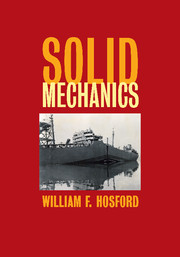Book contents
- Frontmatter
- Contents
- Preface
- 1 Stress and Strain
- 2 Elasticity
- 3 Mechanical Testing
- 4 Strain Hardening of Metals
- 5 Plasticity Theory
- 6 Strain-Rate and Temperature Dependence of Flow Stress
- 7 Viscoelasticity
- 8 Creep and Stress Rupture
- 9 Ductility and Fracture
- 10 Fracture Mechanics
- 11 Fatigue
- 12 Polymers and Ceramics
- 13 Composites
- 14 Mechanical Working
- 15 Anisotropy
- Index
- References
3 - Mechanical Testing
Published online by Cambridge University Press: 05 June 2012
- Frontmatter
- Contents
- Preface
- 1 Stress and Strain
- 2 Elasticity
- 3 Mechanical Testing
- 4 Strain Hardening of Metals
- 5 Plasticity Theory
- 6 Strain-Rate and Temperature Dependence of Flow Stress
- 7 Viscoelasticity
- 8 Creep and Stress Rupture
- 9 Ductility and Fracture
- 10 Fracture Mechanics
- 11 Fatigue
- 12 Polymers and Ceramics
- 13 Composites
- 14 Mechanical Working
- 15 Anisotropy
- Index
- References
Summary
Introduction
Tensile properties are used in the selection of materials for various applications. Material specifications often include minimum tensile properties to assure quality, so tests must be made to insure that materials meet these specifications. Tensile properties are also used in research and development to compare new materials or processes. With plasticity theory (Chapter 5), tensile data can be used to predict a material's behavior under forms of loading other than uniaxial tension.
Often the primary concern is strength. The level of stress that causes appreciable plastic deformation is called its yield stress. The maximum tensile stress that a material carries is called its tensile strength (or ultimate strength or ultimate tensile strength). Both of these measures are used, with appropriate caution, in engineering design. A material's ductility may also be of interest. Ductility describes how much the material can deform before it fractures. Rarely, if ever, is the ductility incorporated directly into design. Rather, it is included in specifications only to assure quality and toughness. Elastic properties may be of interest but these usually are measured ultrasonically.
Tensile Testing
Figure 3.1 shows a typical tensile specimen. It has enlarged ends or shoulders for gripping. The important part of the specimen is the gauge section. The cross-sectional area of the gauge section is less than that of the shoulders and grip region so the deformation will occur here. The gauge section should be long compared to the diameter (typically four times).
- Type
- Chapter
- Information
- Solid Mechanics , pp. 31 - 56Publisher: Cambridge University PressPrint publication year: 2010

